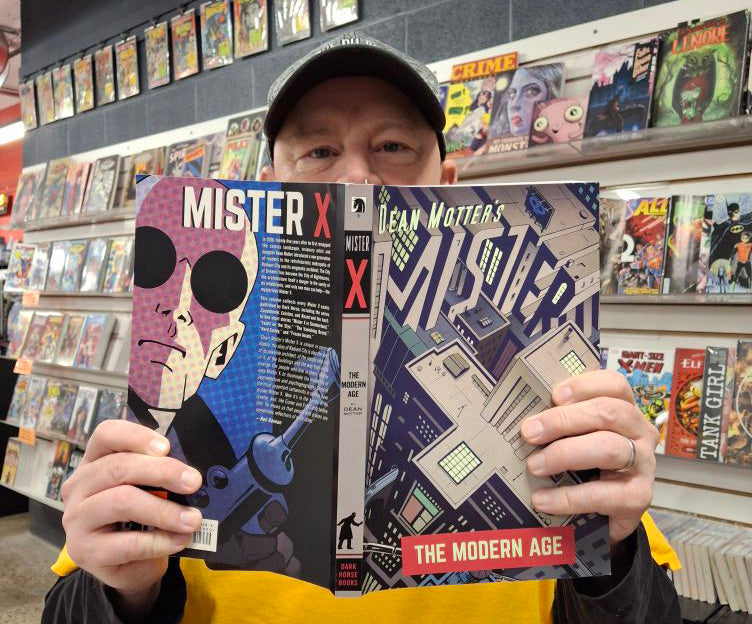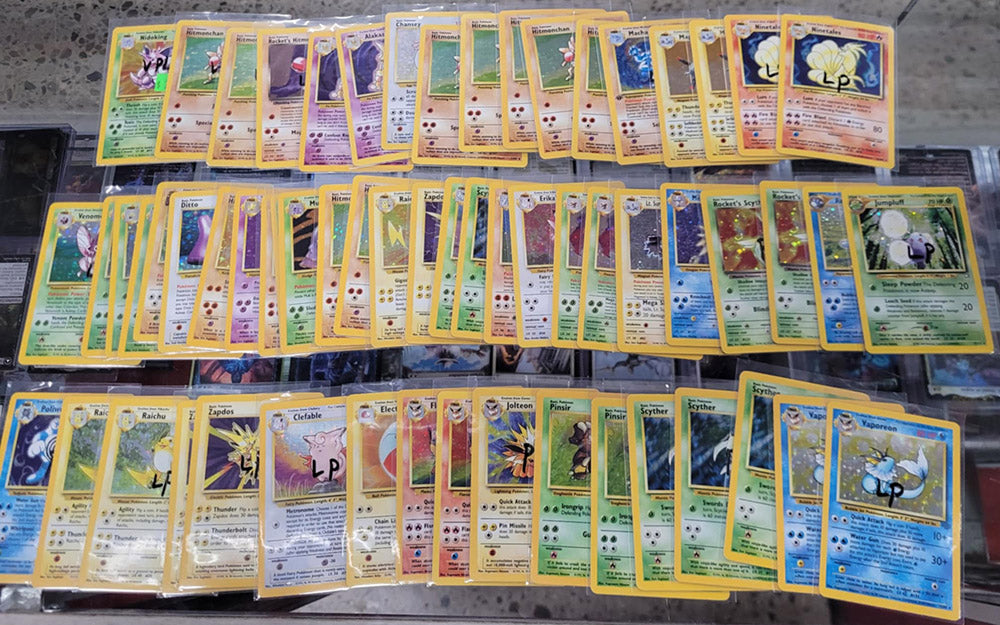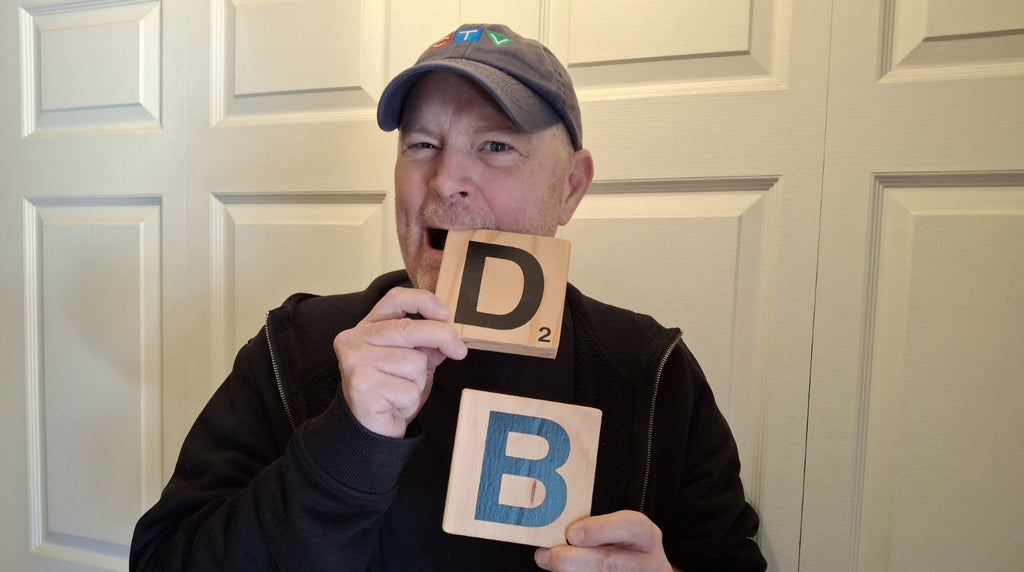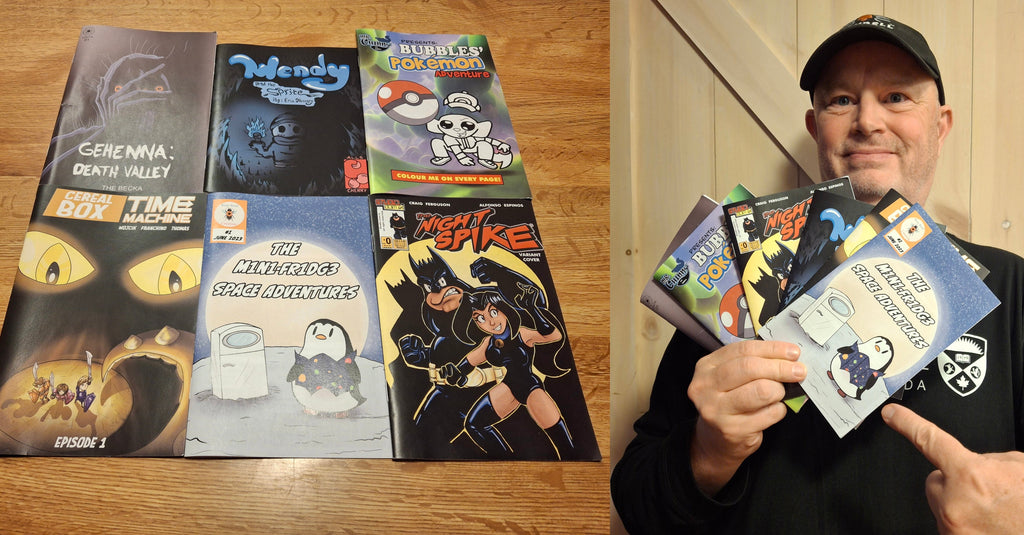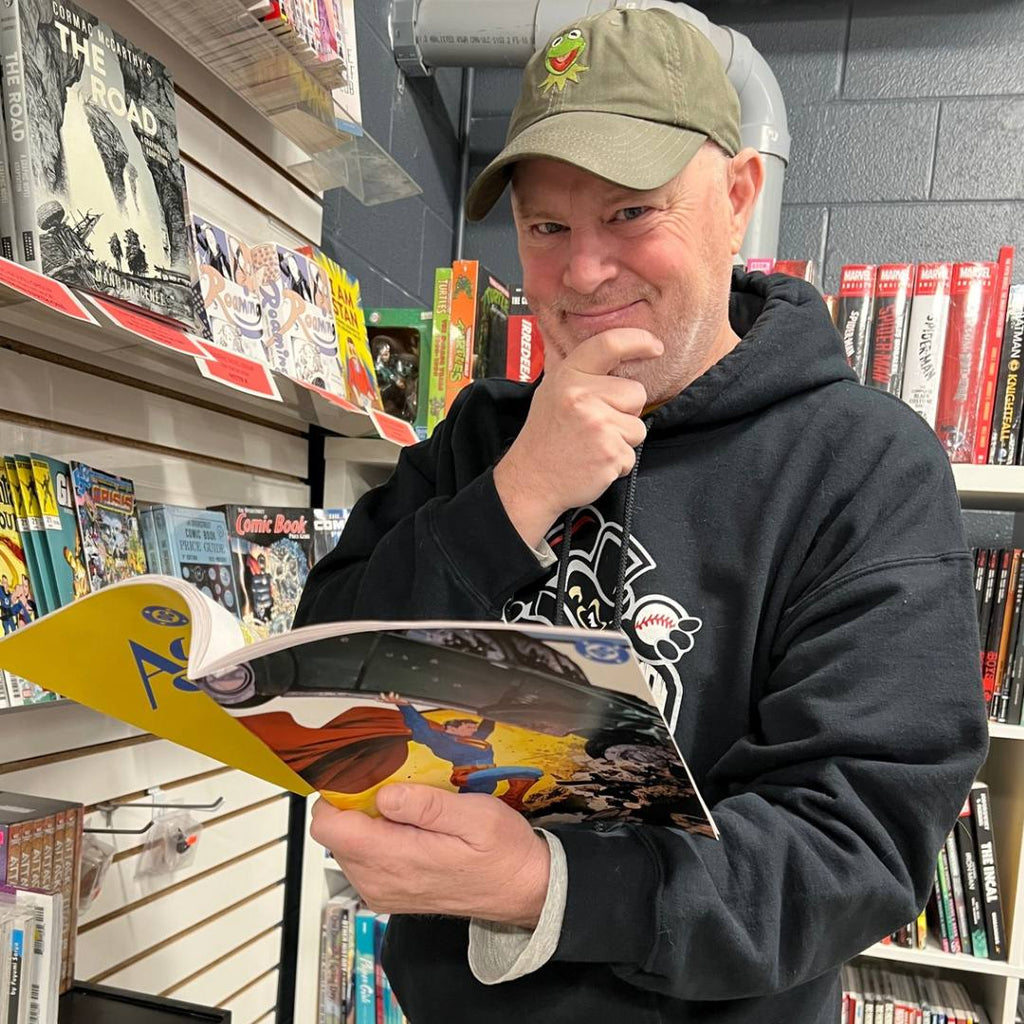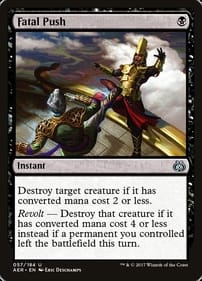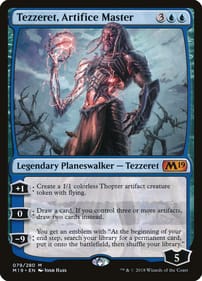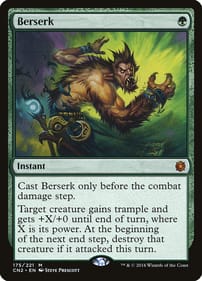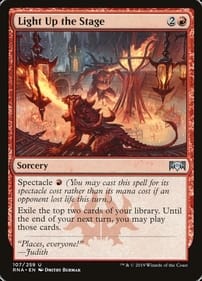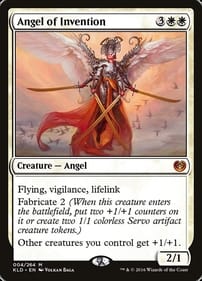GNG Assembles to Talk Mister X
By Dan Brown SPOILER WARNING: This column contains plot details from Dean Motter’s Mister X: The Modern Age, so stop reading right now if you value surprise! Here’s the lowdown on the most recent meeting of the L.A. Mood Graphic-Novel Group, which was held Saturday, June 14. The book: Dean Motter’s Mister X: The Modern Age, which collects all of the Mister X stories published by Dark Horse Comics. The discussion: The full range of opinions was represented around the table. There were people, like me, who love the book. There were others who felt meh – who didn’t give the book a thumb up or down, but a sideways thumb. And there were some who didn’t even feel motivated enough to finish reading the 360-page tome. Gord Mood, L.A. Mood’s co-owner, argued for including Mister X on the 2025 reading list at our January pitch meeting. He is among those who love it. Gord also brought some examples of Motter’s early work from Media 5 when he was a student at Fanshawe College. (Late Town Crier Bill Paul published that sci-fi fan publication.) I knew very little about the character beforehand. Knowing it had been praised for blending film noir, Art Deco and German Expressionism, I was expecting something ponderous and pretentious. Wrong! In my view, it’s an amazing graphic novel. DC can only wish that Batman were as cool as Mister X! It takes place in Radiant City, where it always seems to be 4 a.m. Its nickname is Somnopolis, because of the large number of residents who can’t sleep. The title character is possibly one of the original architects who founded Radiant City, it’s never made clear. The closest he gets to revealing his identity is when he states, “I want to fix my city. I want it to run as designed.” The problem? The city’s architecture is driving its residents insane. None of this, of course, is meant to be taken literally – which Gord’s business partner Carol Vandenberg touched on when she mentioned the humour of the book. The key, for me, was to not take anything in the book at face value. I appreciated how Mister X is a riot of invention. Some members of the group pointed out the many references in the story. For example, one robot who shows up is an homage to Gort from The Day The Earth Stood Still. 1984 is referenced, as well as CanCon icon Nash the Slash. The characters have the clipped speech of detectives in films from the 1940s: “You’re the man without a name,” an interrogator tells Mister X. “That’s what I’m called,” the mystery man replies. Even better, Motter adds his own creative touches, elevating The Modern Age to a level above a mashup. Mister X is an insomnalin addict, meaning if he doesn’t feed his habit, and falls asleep, he will automatically die. There are insomnatoriums on each block. Zombycillin is a drug that can bring the dead to life. Pscychetecture describes the style of buildings in Radiant City and how they torture the human mind. Further reading: Instead of reading, I would say watch Blade Runner or episodes from Batman: The Animated Series, as well as Tim Burton’s 1989 Batman movie. L.A. Mood’s Graphic-Novel Group meets the second Saturday of each month. Next month’s selection is Roaming, by cousin creators Jilliam and Mariko Tamaki. We continue our streak of Canadian books established in recent months! We’ll reconvene July 12 at the gaming tables in the store at 11 a.m. All are invited to come join the discussion! Dan Brown has covered pop culture for more than 32 years as a journalist and also moderates L.A. Mood’s monthly graphic-novel group.
New Pokémon Card Collection Available Starting Saturday, June 14 at 10 AM
New Pokémon Collection Available Starting Saturday, June 14 at 10 AM We have big news! L A Mood has purchased a large collection of vintage English and Japanese Pokémon Wizards of The Coast Era cards. This is your big chance to purchase those rare and hard to find cards. Don't miss out. This collection will be available in store and the following week select cards will be added online. Visit early for best selection! Watch for future emails and Facebook posts for more reveals. This collection will be available in store and the following week select cards will be added online. Visit early for best selection! Watch for future emails and Facebook posts for more reveals.
We are Drowning in Acronyms, LOL
By Dan Brown Have you heard about Donald Trump’s OBBB? Apparently the signature legislation from POTUS may be DOA in the Senate because some legislators object to the SALT and SNAP provisions. If you read those sentences without thinking “WTF?” then you, my friend, have adjusted to life in the Age of the Acronym. Or TAOTA for short. I just made that up. The things are everywhere. You can’t get through the day without running into at least a few of them. If you drive a car, you worry about how many MPG it gets. They also stand for institutions like banks – think TD and BMO. Other acronyms represent such media outlets as CTV, CNN, ABC, and MSNBC. They even stand for people – one of Trump’s most vocal critics is AOC. And apparently RFK’s goal is to MAHA. An early adopter were the four Swedes in the band ABBA. Back then, in the 1970s, acronyms were relatively rare – and fun. They still had some weight because they were found only in a specialized context. The members of the generation growing up back then encountered words like NASA and SCUBA. If you knew what the letters stood for, you belonged to a segment of the population that was educated. Since those days, they’ve multiplied faster than rabbits. You can now find them in every situation. As a 2022 movie’s title indicates, they are EEAAO. In the entertainment sphere, we went from mellow AOR sounds to NWA over the decades. Heck, there was even an X-rated song in the pandemic years titled WAP (you might not wanna look that one up). Another early adopter was the RPG industry, which included the makers of D&D. They have given us terminology like NPC that has now migrated to video games – think WOW or COD, among the more popular titles. They once served a clear purpose. Since the tendency of language is to become more efficient, they made communications faster. Then they really took off when the internet and texting became the dominant ways of getting a message across. LOL. But what’s not funny is how, unfortunately, bureaucrats also seized on them as a way to hide meaning rather than make things clearer. KIA and MIA are anodyne terms that mask a much darker reality, although there was something poetic about CREEP, it was the perfect contraction to describe Richard Nixon’s re-election effort. We’re at the point where a lot of reverse-engineering goes on, too. Some minor government official or political professional will choose a pre-existing word, then come up with the words it stands for, not the other way around. An early example of this was the agency SHIELD in the Marvel Comics of yesteryear. Yes, we rely on acronyms too much. How bad is the situation? It’s gotten to the point where we are now recycling old acronyms, for example POS, which stands for at least three different sets of words that I know of. Our lives are now full of FOMO because we don’t want to miss out on events like a BOGO sale. But hey, let’s face it, it’s not always WYSIWYG. If you don’t mind, I will take a pause RN. I don’t want to get too PO’d. I’ll BRB! Dan Brown has covered pop culture for more than 32 years as a journalist and also moderates L.A. Mood’s monthly graphic-novel group.
Local Mini-comics Are Where It’s At!
By Dan Brown It’s been a month since Free Comic Book Day. So the time is right to go over the freebies handed out at local comic stores like L.A. Mood on May 2 to put a spotlight on the ones that stand out. What really jumped out at me this year are the mini-comics from local creators, more on that in a moment. There were more than 40 titles in all, with something for members of every fandom. Such heroes as the Hulk, Spider-Man, Judge Dredd, Archie, the Thundercats and the Transformers show up. Publishers from Dark Horse to IDW to Image to Boom! are represented. Off the bat, I noticed how Titan Comics extended its streak for having the best cover of the FCBD lot, with the Scourge of the Serpent preview featuring a Roberto De La Torre rendering of everyone’s favourite barbarian, Conan, almost being swallowed by a giant snake. It’s a dynamic image and recalls the glory days of the Cimmerian over at Marvel, when he was drawn by John Buscema. And no surprise, Marvel put out a Fantastic Four sampler – the new FF movie, First Steps, comes out July 25, so expect lots more hype. The story concerns a group of bored teenage aliens who summon Marvel’s First Family by occult/scientific means. The Thing even gets to bellow, “It’s clobberin’ time!” but I’m not a fan of Johnny Storm’s handlebar moustache. (Nor Pedro Pascal’s, as regular readers of this column are aware.) There is a symbolic passing of the torch in I Hate Fairyland, with Byron illustrator Derek Laufman taking over art duties from Skottie Young. You can’t help but dig the four-page splash section Laufman supplies, including a glimpse at Hellicorn – his spoof of a certain demonic anti-hero. London/L.A. writer Sam Maggs is also part of the local contingent, handling script duties on Critical Role: The Mighty Nein Origins. The backup story is a Black Hammer prologue written by another Southwestern Ontario comic creator, Jeff Lemire. Now, about those mini-comics . . . They are not to be missed! Many of them were published by Kitchener’s Studio Comix. There’s a horror offering from Becka Kinzie titled Gehenna: Death Valley in which the characters recognize they are not acting wisely: “This is the stuff from horror movies! Stupid people doing stupid things!” one proclaims when they ignore warnings not to trespass In Wendy and the Sprite, Eric Olscvary sets himself the challenge of writing and drawing a comic about . . . a pile of snow. He more than rises to the occasion. Craig Ferguson and Alfonso Espinos offer readers a tale of the Night Spike, which has a Spy vs. Spy flavour and is also self-aware. At one point, after some back story is related, the Night Spike’s sidekick admits she embellished saying the duo had fought in the Secret Wars: “Well, I just said that to make the flashback a bit more dramatic!” I greatly enjoyed Scott Wojcik’s Cereal Box Time Machine, which tells the story of a trio of young siblings who get their hands on an all-powerful magic wand. They wish for a time machine – in the form of a cereal box – and are transported to a magical setting where they must rid a far-off land from a dragon who looks suspiciously like an overgrown version of their own cat. And I was utterly charmed by The Mini-Fridge Space Adventures from Roxy Reed Creations. It features a spaceship in the shape of a kitchen appliance with a penguin piloting the craft. The whole thing reminded me of Bob Burden’s Flaming Carrot. It also appears the mini-fridge of the title is larger on the inside. Hey, if it worked for a police call box, then why not? Dan Brown has covered pop culture for more than 32 years as a journalist and also moderates L.A. Mood’s monthly graphic-novel group.
But What About the Movie?
By Dan Brown Movie advertising in 2025 is about everything but the movie. What I mean is, the folks in Tinseltown who devise campaigns to advertise big-budget motion pictures, like the latest Mission: Impossible and the upcoming Superman, want the public to be aware of some important details – that have little to do with the content of each film. Why is this a problem? Because Hollywood isn’t exactly doing blockbuster business in the age of streaming. Let me make clear at the outset that I’ve never worked in marketing: This is a civilian take from someone who has never made a movie ad or trailer in his life. All I’m basing my thoughts on are my decades of experience as a moviegoer and movie fan. Let’s start with the obvious example, the publicity campaign for Mission: Impossible – The Final Reckoning, which landed in theatres last month. Whether you’ve seen it yet or not, you already know one thing about this sequel – that Tom Cruise did his own stunt work. You know this factoid because long before Cruise appeared at the Cannes Film Festival or on TV chat shows, Cruise was bragging about it in online clips that appeared while he was still on location two years ago. What he didn’t talk about while hanging off a brightly coloured biplane was the movie’s premise, or his acting in it, or the script. Or any other detail. Doing his own stunts may be a foolish thing for an actor to do, I don’t know, but I do know it’s an odd claim to make since an action star risking certain death in real life and Cruise’s character risking his on-screen life are two different things. What are we supposed to do with this knowledge? Or think of it this way: Did anyone who bought a ticket to see Final Reckoning walk out of the theatre and say to their date, “That movie was pretty mediocre, but I’m just glad knowing Tom Cruise risked life and limb to make it.” As Peter Suderman over at Reason magazine said in his review, the Mission: Impossible films are “ extravagant stunt spectacles, powered by the awe of watching an aging movie star appear to risk his life for our entertainment.” Not by the plot, or the camera work, or anything else intrinsic to the movie. Another example. As Cruise did, many movie actors appear on TV shows like The Tonight Show Starring Jimmy Fallon to drum up interest in their latest work. One question that always comes up while this promoting goes on is how much fun the performers had while making the upcoming feature. This must be very important, as I have never once heard a celebrity plugging the fact they had a bad time on set. There are inevitably anecdotes about what a riot it was to work on the production, and if George Clooney is involved in any way, there will be a story about how he pulled pranks on his co-stars during shooting. Again, does this factor in anyone’s decision to see a particular film over another? Does anyone exiting the movie say, “That was a fantastic film, and knowing the cast had a fun time makes me want to see it again.” Not to be cold, but I don't care. As a moviegoer I just want to be entertained. If a movie is strong, it doesn’t matter to me whether the cast was having fun or utterly miserable. I don’t care. I just want my money’s worth of entertainment. Heck, Martin Sheen had a heart attack during the filming of Apocalypse Now, which can’t have been fun, but I don’t think that fact alone interfered with anyone’s enjoyment or non-enjoyment of the Vietnam War epic. A final example. Word has also reached my online feeds, maybe yours too, how actor David Corenswet put on a large amount of muscle while preparing to play Superman in the James Gunn-directed picture that will reset the DC cinematic universe this summer. These posts show Corenswet pumping iron. Again, I’m not sure what to do with this news nugget. It would be like, if Raging Bull was released today, the studio first released video of Robert De Niro stuffing his face in order to gain the necessary weight to play Jake LaMotta in his over-the-hill years. If publicity tactics like these come across as acts of desperation to you, then I agree. What happened to traditional trailers that tried to give you a sense of the flavour of the film, that boasted about intriguing characters, talented directors and the script’s twists and turns? All of this is another sign Hollywood is in crisis, with the big studios still hurting from the pandemic years and unable to supply a compelling answer to the rise of streaming as the dominant method of entertainment. They’ll do anything to put butts in seats. Now, I’m no marketing genius. But I do see one ploy the Hollywood big brains haven’t used yet that just might work: Try making better movies. Dan Brown has covered pop culture for more than 32 years as a journalist and also moderates L.A. Mood’s monthly graphic-novel group.
Snoopy’s Brother is a Tragic Figure
By Dan Brown Snoopy: Doghouse Tales is the new Peanuts collection aimed at young readers. I’m not young, but I enjoyed it. I’m a fool for Snoopy, as well as his little bird buddy Woodstock. I recommend this one if you want to learn more about Snoopy’s family – not the human one Charlie Brown belongs to, but Snoopy’s dog siblings. A fair number of the strips in this 172-page collection feature Spike, one of Snoopy’s brothers. Spike has always struck me as a tragic figure, so kids might learn some empathy reading this one. What do we know about Spike, apart from the fact he is Snoopy’s bro? Here’s a few details I gleaned from Doghouse Tales. He lives in the Mojave Desert near Needles, California. He has droopy eyes plus droopy whiskers, which look like a sad moustache. He’s rail thin. (It’s Snoopy’s brother Olaf who looks like he swallowed a Butterball turkey whole). He wears a bedraggled old fedora, which was once his grandfather’s fishing hat.. And there’s also something else important that readers learn – Spike has no human friends or family, no Charlie Brown figure in his life. And no Sally or Lucy or Linus, either. This is a large part of why my heart goes out to him: He seems so alone. Whenever we see Spike in his element, he’s surrounded only by sand and cacti. And as we know from the tree that munches on Charlie Brown’s kites, plants in the Peanuts universe can be menacing. Sure enough, in one of the collected strips a cactus catches a football Spike has thrown – it slowly deflates when it gets punctured by the cactus needles. It’s a contrast to other moments, as when a cactus holds an umbrella to shield Spike from a rare rainstorm in the desert. You know Charles Schulz was a powerful cartoonist and storyteller when he is able to invest a minor character like Spike with so much personality. It’s also interesting to see that while Spike has an active imagination, he has no full-on flights of fantasy the same way Snoopy does. Spike never takes a trip in his mind to the First World War battlefield, he is always stuck in the now. In one of his letters to Snoopy, Spike describes his circumstances, writing “Life here on the desert is hard but wonderful. Sometimes it is very hot. And the nights can be cold . . . But there are always beautiful places to walk and things to see.” That sounds like a spartan existence, but not without its charms. I’m constantly amazed at how Schulz was able to grind out newspaper strip after strip over the decades. I’m guessing such characters as Spike offered him a bit of a respite, allowing him to take a break from drawing cartoons about the “main” Peanuts gang by exercising a different set of storytelling muscles. There are the usual shenanigans in this anthology too. Lucy continues to vex pitcher/manager Charlie Brown from the outfield by blowing routine baseball plays. Peppermint Patty continues to receive D-minus grades, at one point being held back a grade before she is reinstated the following September, much to her friend Marci’s chagrin. In another four-panel sequence, Snoopy lets loose as a dancer, calling himself a “Flashbeagle,” which gives you some sense of when these strips originally appeared – around the time the 1983 flick Flashdance was in theatres. Doghouse Tales is published by Andrews McMeel Syndication. Purists will note the strips appear here in colour, not in black-and-white as they originally did Monday to Friday in daily newspapers. Dan Brown has covered pop culture for more than 32 years as a journalist and also moderates L.A. Mood’s monthly graphic-novel group.


